下雨了,大风降温,一地树叶,终于进入冬季了



代码:
%% ------------------------------------------------------------------------
%% Output Info about this m-file
fprintf('
***********************************************************
');
fprintf(' <DSP using MATLAB> Problem 8.46.4
');
banner();
%% ------------------------------------------------------------------------
% Digital Filter Specifications: Elliptic bandpass
wsbp = [0.30*pi 0.60*pi]; % digital stopband freq in rad
wpbp = [0.35*pi 0.50*pi]; % digital passband freq in rad
Rp = 1.00; % passband ripple in dB
As = 40; % stopband attenuation in dB
Ripple = 10 ^ (-Rp/20) % passband ripple in absolute
Attn = 10 ^ (-As/20) % stopband attenuation in absolute
fprintf('
*******Digital bandpass, Coefficients of DIRECT-form***********
');
[bbp, abp] = elipbpf(wpbp, wsbp, Rp, As)
[C, B, A] = dir2cas(bbp, abp)
% Calculation of Frequency Response:
[dbbp, magbp, phabp, grdbp, wwbp] = freqz_m(bbp, abp);
% ---------------------------------------------------------------
% find Actual Passband Ripple and Min Stopband attenuation
% ---------------------------------------------------------------
delta_w = 2*pi/1000;
Rp_bp = -(min(dbbp(ceil(wpbp(1)/delta_w+1):1:ceil(wpbp(2)/delta_w+1)))); % Actual Passband Ripple
fprintf('
Actual Passband Ripple is %.4f dB.
', Rp_bp);
As_bp = -round(max(dbbp(1:1:ceil(wsbp(1)/delta_w)+1))); % Min Stopband attenuation
fprintf('
Min Stopband attenuation is %.4f dB.
', As_bp);
%% -----------------------------------------------------------------
%% Plot
%% -----------------------------------------------------------------
figure('NumberTitle', 'off', 'Name', 'Problem 8.46.4 Elliptic bp by elipbpf function')
set(gcf,'Color','white');
M = 1; % Omega max
subplot(2,2,1); plot(wwbp/pi, magbp); axis([0, M, 0, 1.2]); grid on;
xlabel('Digital frequency in pi units'); ylabel('|H|'); title('Magnitude Response');
set(gca, 'XTickMode', 'manual', 'XTick', [0, 0.3, 0.35, 0.5, 0.6, M]);
set(gca, 'YTickMode', 'manual', 'YTick', [0, 0.01, 0.8913, 1]);
subplot(2,2,2); plot(wwbp/pi, dbbp); axis([0, M, -100, 2]); grid on;
xlabel('Digital frequency in pi units'); ylabel('Decibels'); title('Magnitude in dB');
set(gca, 'XTickMode', 'manual', 'XTick', [0, 0.3, 0.35, 0.5, 0.6, M]);
set(gca, 'YTickMode', 'manual', 'YTick', [-80, -40, -1, 0]);
set(gca,'YTickLabelMode','manual','YTickLabel',['80'; '40';'1 ';' 0']);
subplot(2,2,3); plot(wwbp/pi, phabp/pi); axis([0, M, -1.1, 1.1]); grid on;
xlabel('Digital frequency in pi nuits'); ylabel('radians in pi units'); title('Phase Response');
set(gca, 'XTickMode', 'manual', 'XTick', [0, 0.3, 0.35, 0.5, 0.6, M]);
set(gca, 'YTickMode', 'manual', 'YTick', [-1:0.5:1]);
subplot(2,2,4); plot(wwbp/pi, grdbp); axis([0, M, 0, 80]); grid on;
xlabel('Digital frequency in pi units'); ylabel('Samples'); title('Group Delay');
set(gca, 'XTickMode', 'manual', 'XTick', [0, 0.3, 0.35, 0.5, 0.6, M]);
set(gca, 'YTickMode', 'manual', 'YTick', [0:20:80]);
figure('NumberTitle', 'off', 'Name', 'Problem 8.46.4 Pole-Zero Plot')
set(gcf,'Color','white');
zplane(bbp, abp);
title(sprintf('Pole-Zero Plot'));
%pzplotz(b,a);
% -----------------------------------------------------
% method 3 elip function
% -----------------------------------------------------
% Calculation of Elliptic filter parameters:
[N, wn] = ellipord(wpbp/pi, wsbp/pi, Rp, As);
fprintf('
********* Elliptic Digital Bandpass Filter Order is = %3.0f
', 2*N)
% Digital Elliptic Bandpass Filter Design:
[bbp, abp] = ellip(N, Rp, As, wn)
[C, B, A] = dir2cas(bbp, abp)
% Calculation of Frequency Response:
[dbbp, magbp, phabp, grdbp, wwbp] = freqz_m(bbp, abp);
% ---------------------------------------------------------------
% find Actual Passband Ripple and Min Stopband attenuation
% ---------------------------------------------------------------
delta_w = 2*pi/1000;
Rp_bp = -(min(dbbp(ceil(wpbp(1)/delta_w+1):1:ceil(wpbp(2)/delta_w+1)))); % Actual Passband Ripple
fprintf('
Actual Passband Ripple is %.4f dB.
', Rp_bp);
As_bp = -round(max(dbbp(1:1:ceil(wsbp(1)/delta_w)+1))); % Min Stopband attenuation
fprintf('
Min Stopband attenuation is %.4f dB.
', As_bp);
%% -----------------------------------------------------------------
%% Plot
%% -----------------------------------------------------------------
figure('NumberTitle', 'off', 'Name', 'Problem 8.46.4 Elliptic bp by ellip function')
set(gcf,'Color','white');
M = 1; % Omega max
subplot(2,2,1); plot(wwbp/pi, magbp); axis([0, M, 0, 1.2]); grid on;
xlabel('Digital frequency in pi units'); ylabel('|H|'); title('Magnitude Response');
set(gca, 'XTickMode', 'manual', 'XTick', [0, 0.3, 0.35, 0.5, 0.6, M]);
set(gca, 'YTickMode', 'manual', 'YTick', [0, 0.01, 0.8913, 1]);
subplot(2,2,2); plot(wwbp/pi, dbbp); axis([0, M, -100, 2]); grid on;
xlabel('Digital frequency in pi units'); ylabel('Decibels'); title('Magnitude in dB');
set(gca, 'XTickMode', 'manual', 'XTick', [0, 0.3, 0.35, 0.5, 0.6, M]);
set(gca, 'YTickMode', 'manual', 'YTick', [-80, -40, -1, 0]);
set(gca,'YTickLabelMode','manual','YTickLabel',['80'; '40';'1 ';' 0']);
subplot(2,2,3); plot(wwbp/pi, phabp/pi); axis([0, M, -1.1, 1.1]); grid on;
xlabel('Digital frequency in pi nuits'); ylabel('radians in pi units'); title('Phase Response');
set(gca, 'XTickMode', 'manual', 'XTick', [0, 0.3, 0.35, 0.5, 0.6, M]);
set(gca, 'YTickMode', 'manual', 'YTick', [-1:0.5:1]);
subplot(2,2,4); plot(wwbp/pi, grdbp); axis([0, M, 0, 100]); grid on;
xlabel('Digital frequency in pi units'); ylabel('Samples'); title('Group Delay');
set(gca, 'XTickMode', 'manual', 'XTick', [0, 0.3, 0.35, 0.5, 0.6, M]);
set(gca, 'YTickMode', 'manual', 'YTick', [0:30:90]);
运行结果:
看题目,是Elliptic型数字带通,设计指标,DB转换成绝对指标
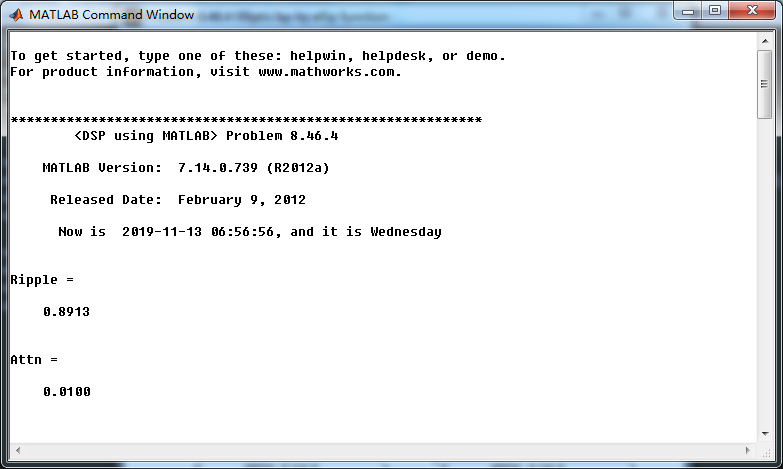
Elliptic模拟低通原型阶数是4,使用elipbpf函数设计带通,系统函数直接形式和串联形式的系数如下,
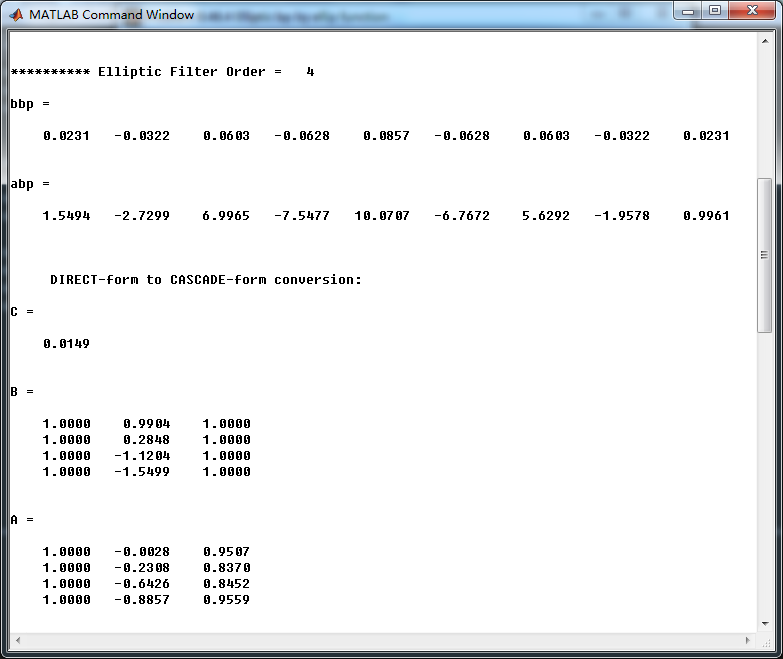
幅度谱、相位谱和群延迟响应
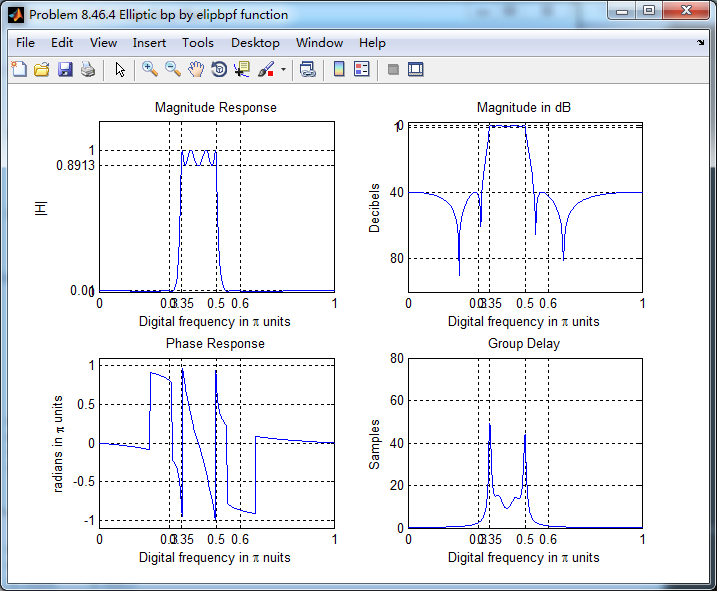
零极点图

采用elip函数(MATLAB工具箱函数),设计带通,阶数是8阶,系统函数直接形式和串联形式的系数如下
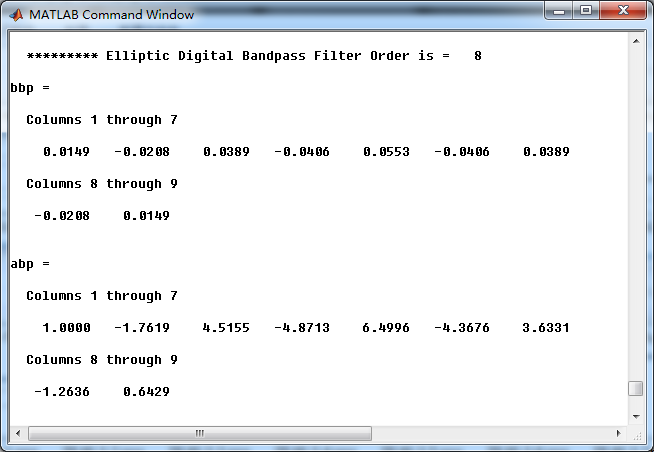

幅度谱、相位谱和群延迟响应
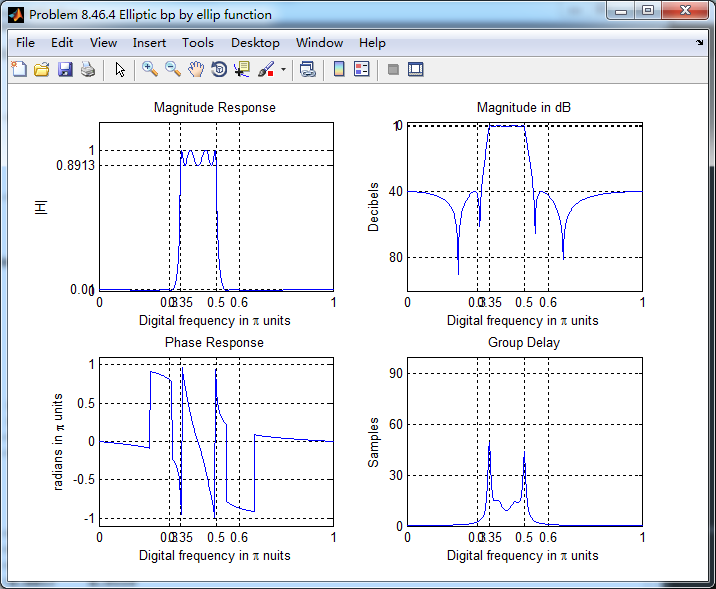
给定通带、阻带衰减处的精确频带边界频率,我暂时不会计算,以后学会了再放图吧。